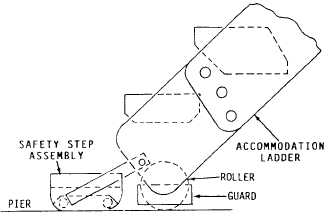| |
With this equipage rigged, we are ready to lower the
ladder. Attach the falls to a sling on the lower platform.
Make sure the hook is moused so the sling does not fall
out of the hook.
If outriggers were used or if pad eyes and two-fold
are holding the ladder, we must lay back on the falls to
take the weight of the ladder off of them. Swing the
outriggers in and or disengage the ladder from the pad
eyes and remove the two-fold. The weight of the ladder
is now on the falls attached to the lower platform and
the attachment points of the upper platform.
The accommodation ladder should be lowered
smoothly and it must always be controlled in its
descent. As the ladder lowers into position, the pendant
will extend itself between the attachment point and the
bail. Keep an eye on the bridle and bail to make sure that
they are not fouled as the ladder is lowered. The weight
of the ladder will shift to the pendant, the bail, and the
bridle when the ladder is in its down position. A crew
member must now go down the ladder and rig the shoes.
Shoes on an accommodation ladder are posts that slide
out from the lower platform and act as fenders to keep
the ladder in the proper position off the side of the ship.
The shoes are secured by pins set in from the top of the
lower platform into pre-drilled holes in the shoes.
Turnbuckles are now rigged from the lower platform to
the side of the ship. They prevent the fore and aft
movement of the ladder.
While this is being done, another sailor rigs the boat
line. The boat line is nothing more than a block rigged
under the forward outboard corner of the upper plat-
form. It acts as a sea painter to help boats making
landing at the ladder.
The rails of the ladder are not set up and secured
into position.
Remember that in some of these rigging
procedures, personnel will be working outside of
lifelines and over the side of the ship. It is absolutely
necessary for these personnel to be in life jackets and
safety harnesses with proper safety lines rigged. While
underway, the Commanding Officer must give
permission before anyone can work over the side.
Pneumatic fenders are now lowered over the side of
the ship. They are positioned fore and aft of the
accommodation ladder to protect the ladder and the ship
from boats coming alongside.
When you complete the steps in rigging the
accommodation ladder, you are ready to receive boats
alongside. One of the marks of a smart efficient ship,
4-20
when going to anchorage is not only the proper use of
her ground tackle but the timely manner in which she
has her accommodation ladders and boat boom rigged.
As previously mentioned, some accommodation
ladders can be modified for use on a pier or barge. To
do this, the lower platform and the H-Frame are left off,
and a roller and a safety step are installed at the bottom
of the ladder, as shown in figure 4-19. The safety step
assembly eliminates the foot hazard caused by the
ladder roller.
BOAT BOOMS
LEARNING OBJECTIVES: Define boat boom.
Describe the purpose of the boat boom.
Ships that are at anchor, or are moored to a buoy, rig
out their boat booms for the purpose of mooring their
boats well clear of the side. This method of securing is
known as “hauling out to the boom.” Forward booms
are called lower booms, after booms are called quarter
booms.
The boat boom (fig. 4-20) is a spar secured by a
gooseneck to a pin on the side of the ship, which allows
free motion fore and aft. The outboard end of the boom
hangs from a wire and tackle combination called the
topping lift. Nylon or wire rope forward and after guys
control the fore-and-aft motion.
A strong line called a guess-warp leads from well
forward on the ship, out through a block in the end of
the boom, and ends in a metal thimble through which
boats can reeve their bow lines. A toggle is seized
between strands of the guess-warp above the thimble to
keep it from running up (out of reach) when a boat lets
go. One or more Jacob's ladders from the boom permit
boat crews to come aboard.
Figure 4-19.–Accommodation ladder rigged to pier.
|

